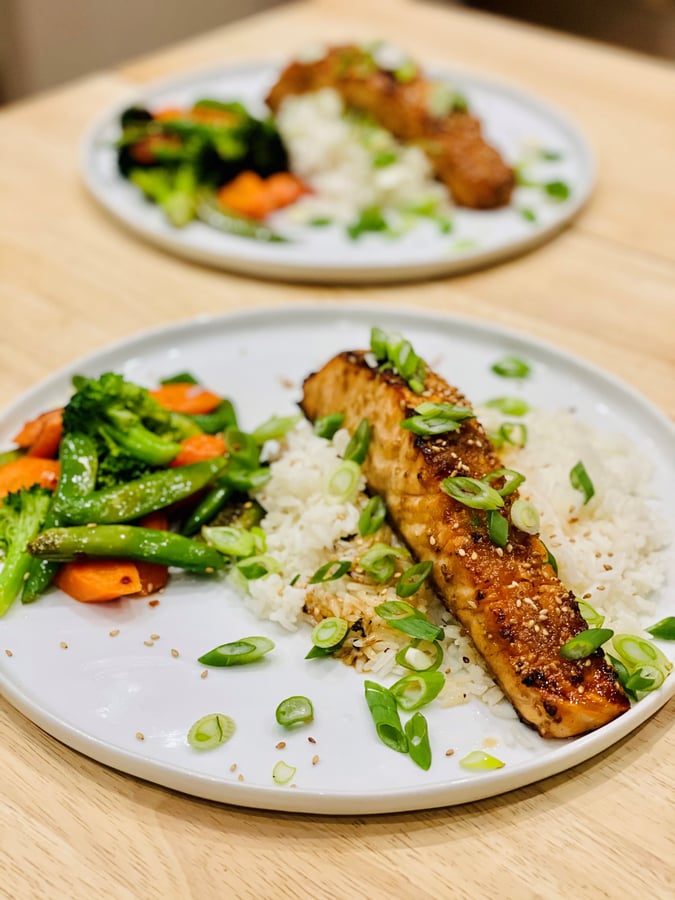
I had so many food issues as a kid. Most of them are behind me now, except when it comes to coconut. I have to admit to still holding on to my strong dislike for it. As hard as I’ve tried, its flavor and texture are things that I just can’t get past. The other one that stayed with me for quite a while was salmon. It took me the longest time to finally appreciate the flavor and oily taste of it, which I’m sure had to lot to do with my past dislike of any type of fish... period.
It all started when I was presented with my first piece of fried fish when I was a kid. The plate of fried fish was put in front of me by my grandfather as he warned me to be careful when eating the fish and to avoid the bones at all costs. And then the warning went on further to declare, that if I, by mistake, were to eat a bone, I could possibly choke on the bone and die. Well, 8-year-old me wasn’t about to have any part of that dinner! I ended up just picking at the fried cornbread coating and gobbling down all the coleslaw I could devour.
Unfortunately, that fear of choking on a bone when eating fish stayed with me until I became an adult. And this had an embarrassing consequence when I had an opportunity to visit family in Arkansas and meet my great-grandmother for the very first time.
I was 19 and my partner Fernando and I were taking our first road trip together to Mexico. On the way, we planned to make a detour through Arkansas in order to visit family. This was special as this was my very first time visiting my family in Arkansas. And this visit would give me the chance to be able to spend time with my grandfather and finally meet my great-grandmother who I had heard so much about. My great-grandmother must have been in her 90’s at the time, very active, still driving, and I had heard that she loved fishing and would go fishing practically every day when she could.
The day we showed up in Arkansas, she was so excited about finally having the opportunity to meet her great-grandson that she went fishing and caught lots of catfish to prepare for dinner that night. I had no idea that she was planning a very special meal for us that involved fish! We sat down at the kitchen table and she put down the two plates of fried catfish with a heaping helping of coleslaw in front of us. I, obviously not thinking very clearly, told my great-grandmother that I didn’t like fish and that I didn’t want any. The disappointed look on her face will always stay with me. To this day, I absolutely regret not even trying her catfish. I ended up getting a generous helping of coleslaw, and Fernando got my catfish. My great-grandmother gave Fernando an extra helping along with that special Southern love for being the catfish-loving, substitute great-grandson that she had now adopted.
As my pallet matured, I eventually grew to appreciate eating fish of all types, except for one fish - salmon. However, I was making some progress because I was finally appreciating eating raw sushi-grade salmon and brined salmon, or “lox”. For some reason, I had grown to love the taste of salmon sushi as well as a good lox and bagel. But once the salmon was cooked, there was something about the texture and oily flavor that I just couldn’t stomach. That was, until I discovered a couple of recipes for cooking salmon that toned down its oily flavors and brought out its other subtle and milder flavors.
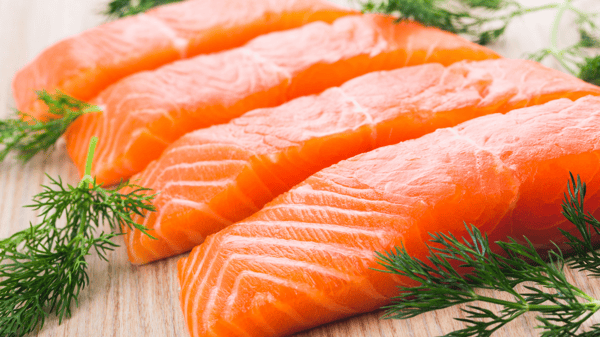 My journey that would transform me from a salmon hater to a salmon lover all began with my wanting to eat healthier by incorporating more fish into my diet. Salmon is a great source of protein, it contains potassium, vitamin B12 and is rich in omega-3 fatty acids, which help contribute to healthy brain, heart and joint functions. And that eventually led me into research on not only recipes for salmon, but on the many types of salmon as well, because not all varieties of salmon look or taste the same.
My journey that would transform me from a salmon hater to a salmon lover all began with my wanting to eat healthier by incorporating more fish into my diet. Salmon is a great source of protein, it contains potassium, vitamin B12 and is rich in omega-3 fatty acids, which help contribute to healthy brain, heart and joint functions. And that eventually led me into research on not only recipes for salmon, but on the many types of salmon as well, because not all varieties of salmon look or taste the same.
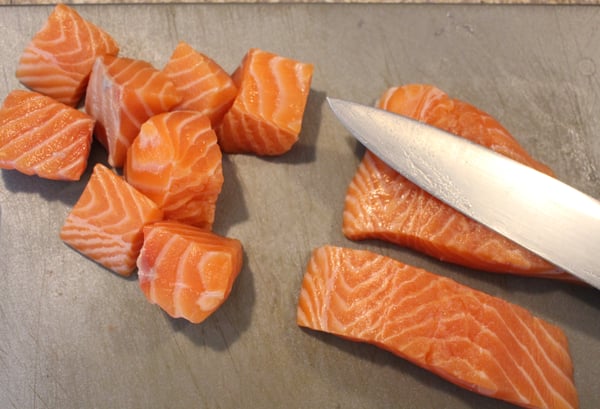 Here’s a list of several types of salmon available on the market today:
Here’s a list of several types of salmon available on the market today:
Sockeye salmon is a Pacific variety that is easily recognizable by its deep red color, fatty texture, and strong smell.
Coho salmon, also known as silver salmon, is best for those who don’t like the bold flavor of sockeye salmon. A whole fish can weigh between 23-24 pounds, so you can easily cook the entire fish on a grill or smoker. It is also found in the Pacific.
Pink or humpback salmon is the most basic variety of salmon on the market. It is light pink in color, mild tasting and low in fat. In the water, it is recognizable by its distinctive humps when spawning.
Chum salmon is one of the smallest varieties at around 8 pounds. It is mainly used for its large roe, that is available in jars or frozen. You can also find it in filet form under the name keta salmon. It has less oil therefore lighter in taste than sockeye.
Steelhead salmon is actually ocean trout that migrates upstream, like its cousin, and has a similar texture and flavor.
Atlantic salmon is salmon that is farm-raised. It is artificially colored, and available year-round. It is important to know how farmed Atlantic salmon was raised, what type of feed it was given, and whether it was fed antibiotics, in order for you to make a call on its sustainability. Farm-raised salmon is typically fattier than wild-caught salmon and has more calories, but is still very nutritious.
King salmon or Chinook salmon is one of the rarer species of salmon and one of the best that money can buy. It has more flavor, thicker meat, and more nutritional value. Available in shades of pink, orange and marble. King salmon is typically found in the Pacific Northwest, Alaska and parts of Asia.
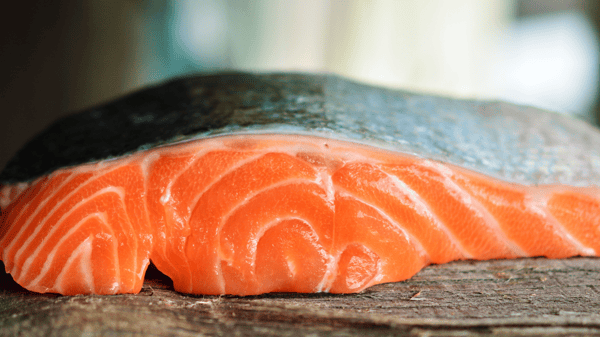
Buying Salmon
When buying salmon from a store, look at its color. It should be light pink if farm raised, and dark pink if wild caught, and not have any gray or brown areas. Its smell should be mild and not fishy, (a briny, oceanic scent is good), and it should be firm and not slimy to the touch.
While researching recipes for salmon, I really wanted a recipe that would downplay its oily flavor and accentuate and bring out its subtler flavors. Two recipes that turned out to be my favorites contained several Asian ingredients, notably ginger, garlic, soy sauce, and one that contained the ingredient, white miso paste. They both also have the cooking technique of being broiled, which I find to be perfect for cooking salmon. The technique of broiling incorporates a nice charring and caramelization into the salmon, bringing out a mild sweet flavor, especially being that both recipes have a nice rich glaze.
I have to admit that Asian ingredients are some of my favorite ones to cook with. And I love Asian recipes, because those recipes can run the gamut from Thai to Japanese to Southeast Asian dishes and more.
One recipe was intentionally constructed to serve only two people, which works perfectly for my household. And the second one I was easily able to adjust for two servings. The recipe for Miso-Marinated Salmon for Two, that I adapted from America's Test Kitchen, was for the longest time my go-to for my weekly salmon fix. That was until I happened upon a toasted sesame and ginger recipe that I eventually adapted to make my own, and that is now the favorite for my weekly salmon fix.
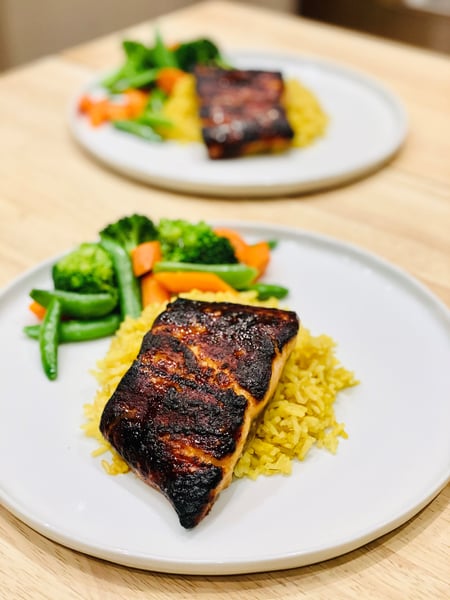 Miso-marinated salmon for two with rice and steamed vegetables
Miso-marinated salmon for two with rice and steamed vegetables
The recipe involves broiling salmon, which incorporates a charring effect and adds a nice caramelization to the salmon, helping bring out its mild flavor. But I suggest keeping a keen eye on the salmon during the broiling process, making sure to avoid any flare ups that might occur because of the sugar in the recipe.
Toasted Sesame Ginger Salmon
Scroll down for a printable version of this recipe
Prep time: 15 minutes
Cook time: 8-10 minutes
Marinating time: 30 minutes
Total time: 55 minutes
Serves: 2
2 (6-8 ounce) portions of skin-on salmon fillets
1/8 cup olive oil
1 tablespoon toasted sesame oil
1 tablespoon rice vinegar
1 tablespoon brown sugar
1 tablespoon soy sauce
2 garlic cloves minced or chopped finely
2 teaspoons freshly grated ginger
1 tablespoon toasted sesame seeds
1/8 teaspoon crushed red pepper flakes
Salt and pepper to taste
For Sesame Ginger Honey Glaze:
2 tablespoons honey
1/2 teaspoon toasted sesame oil
1 teaspoon soy sauce
1/2 teaspoon freshly grated ginger
1/2 teaspoon toasted sesame seeds for garnish
2 green onions sliced on the bias for garnish
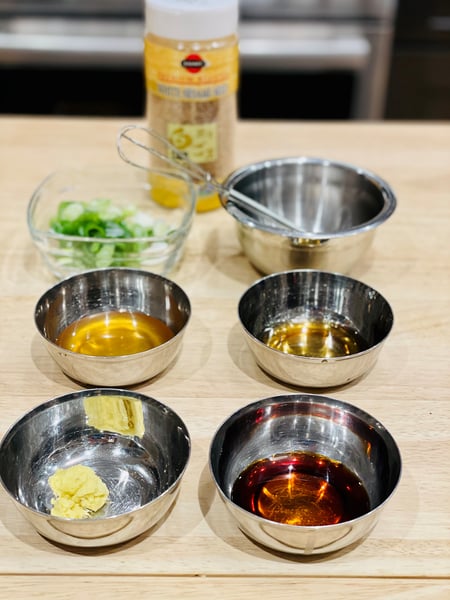 1. Line a baking sheet and wire rack with aluminum foil and spray the foil-lined rack with nonstick cooking spray.
1. Line a baking sheet and wire rack with aluminum foil and spray the foil-lined rack with nonstick cooking spray.
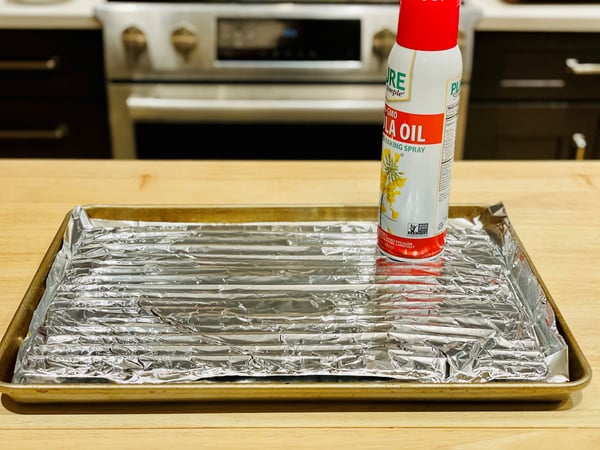 2. In a medium bowl or baking dish, combine olive oil, sesame oil, soy sauce, garlic, ginger, rice vinegar, brown sugar, sesame seeds and crushed red pepper flakes and whisk until well combined. Add salmon to a baking dish or place in a zippered bag, add the marinade and then refrigerate for at least 30 minutes.
2. In a medium bowl or baking dish, combine olive oil, sesame oil, soy sauce, garlic, ginger, rice vinegar, brown sugar, sesame seeds and crushed red pepper flakes and whisk until well combined. Add salmon to a baking dish or place in a zippered bag, add the marinade and then refrigerate for at least 30 minutes.
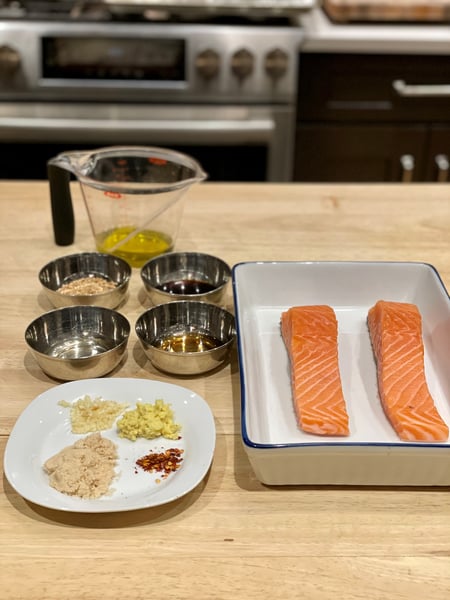
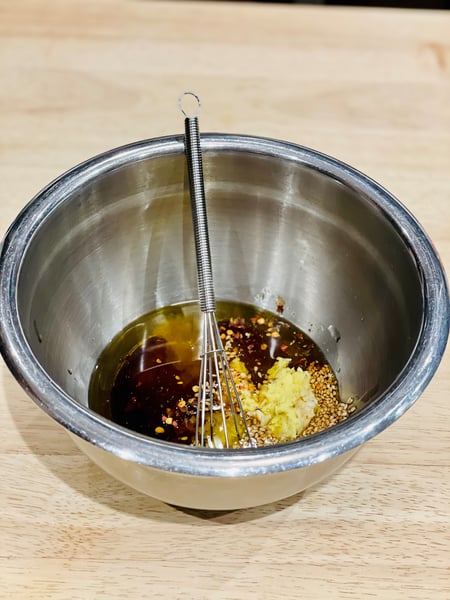
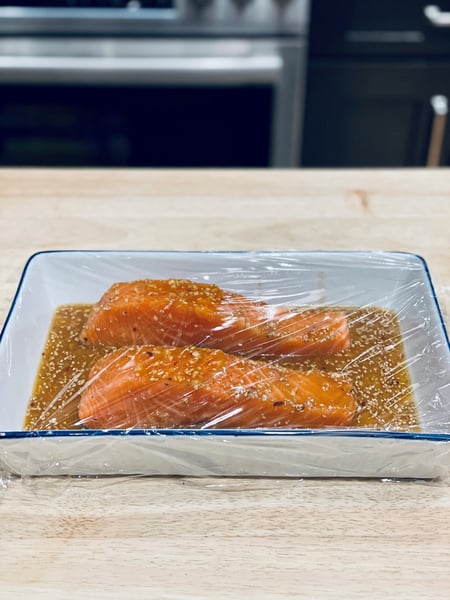 3. Preheat the broiler in your oven, (or preheat your grill if you prefer).
3. Preheat the broiler in your oven, (or preheat your grill if you prefer).
4. Remove salmon from the marinade and place directly on the foil lined wire rack.
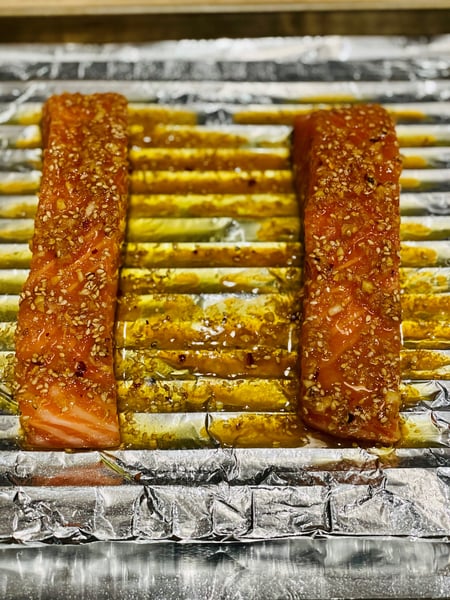 5. Sprinkle with a bit of salt and pepper, then place on the middle rack of your oven under the broiler. Broil for 8-10 minutes, depending on the thickness of the salmon fillet, being sure to keep an eye on the broiling process in order to avoid any flare ups.
5. Sprinkle with a bit of salt and pepper, then place on the middle rack of your oven under the broiler. Broil for 8-10 minutes, depending on the thickness of the salmon fillet, being sure to keep an eye on the broiling process in order to avoid any flare ups.
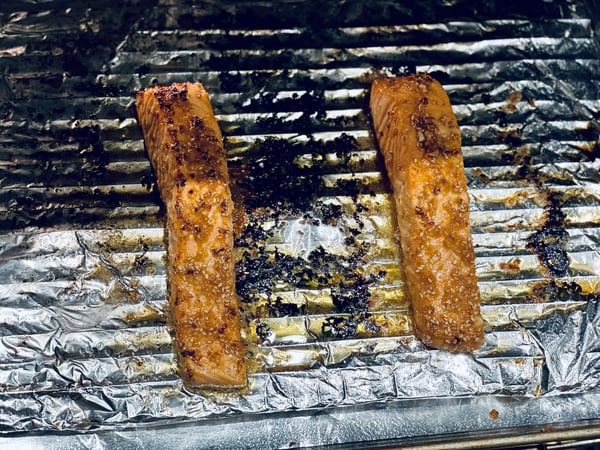 6. If you want you can flip the salmon halfway through the cooking process and crisp up the salmon skin.
6. If you want you can flip the salmon halfway through the cooking process and crisp up the salmon skin.
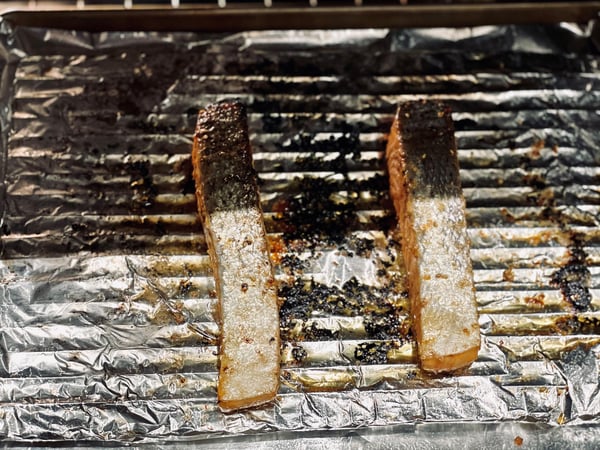 7. Remove the salmon from the oven, serve immediately, with the glaze, a sprinkling of the toasted sesame seeds, and the sliced green onions.
7. Remove the salmon from the oven, serve immediately, with the glaze, a sprinkling of the toasted sesame seeds, and the sliced green onions.
This salmon recipe is perfect served alongside a scoop of jasmine rice and either steamed or stir-fried veggies.
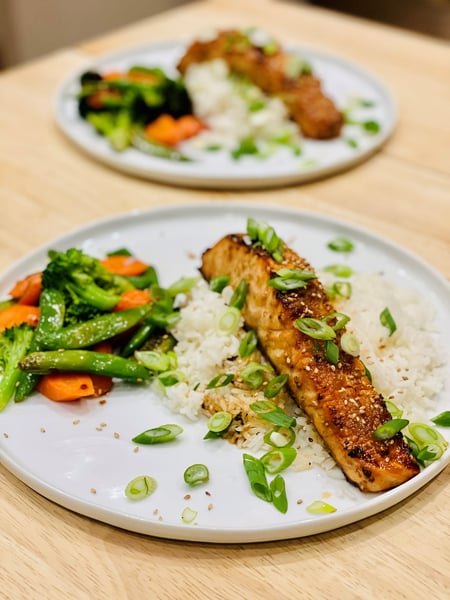 For more ways to work with salmon, check out The Chopping Block's upcoming virtual Sunday Dinner cooking class featuring Tuscan Salmon on Sunday, March at 4pm CST. You'll learn how to make:
For more ways to work with salmon, check out The Chopping Block's upcoming virtual Sunday Dinner cooking class featuring Tuscan Salmon on Sunday, March at 4pm CST. You'll learn how to make:
- Sautéed Salmon with Sun Dried Tomato-Garlic Cream Sauce
- Steamed Rice with Parmesan and Peas
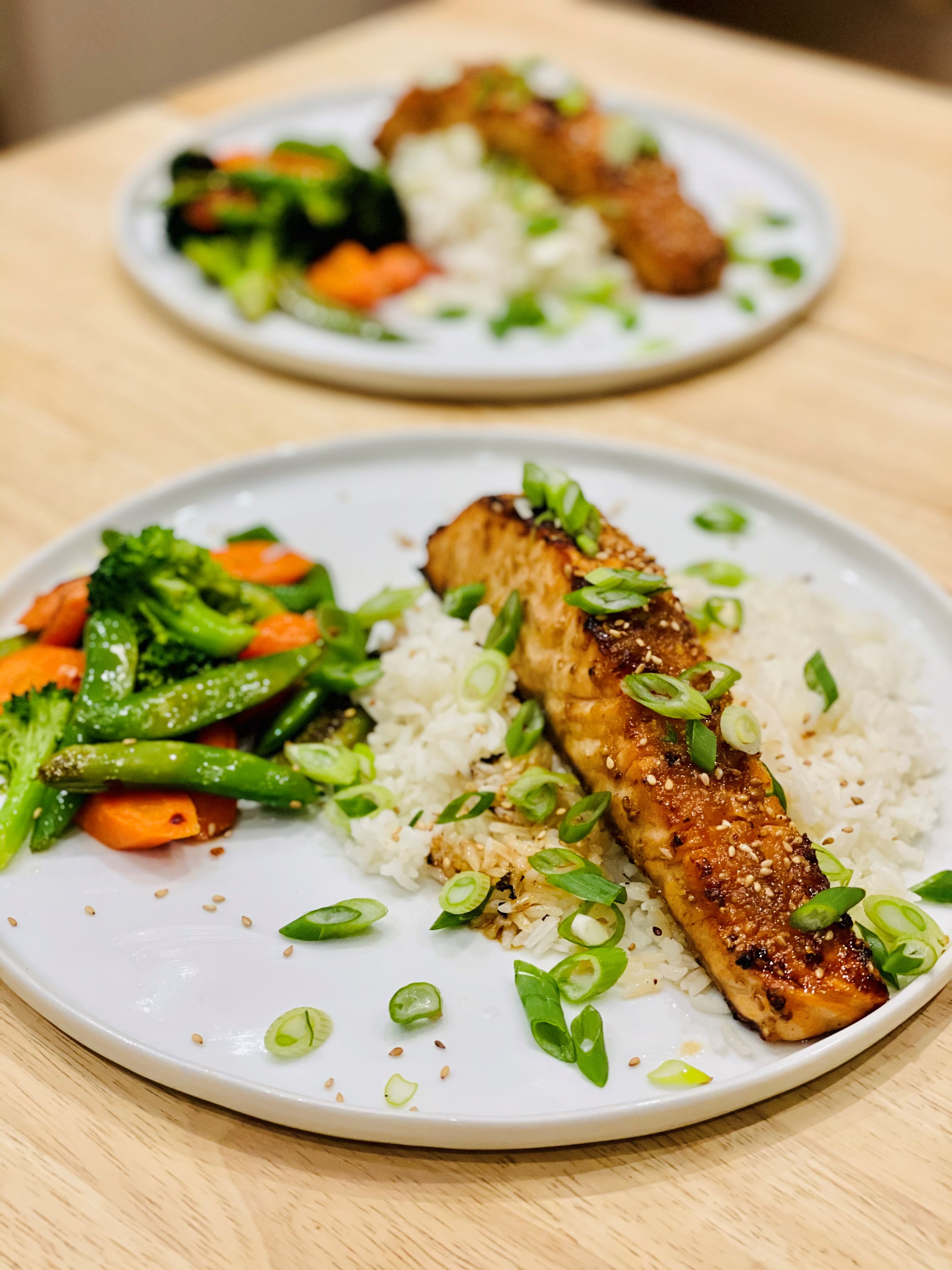
Toasted Sesame Ginger Salmon
Ingredients
- 2 (6-8 ounce) portions of skin-on salmon fillets
- 1/8 cup olive oil
- 1 tablespoon toasted sesame oil
- 1 tablespoon rice vinegar
- 1 tablespoon brown sugar
- 1 tablespoon soy sauce
- 2 garlic cloves minced or chopped finely
- 2 teaspoons freshly grated ginger
- 1 tablespoon toasted sesame seeds
- 1/8 teaspoon crushed red pepper flakes
- Salt and pepper to taste
- 2 tablespoons honey
- 1/2 teaspoon toasted sesame oil
- 1 teaspoon soy sauce
- 1/2 teaspoon freshly grated ginger
- 1/2 teaspoon toasted sesame seeds for garnish
- 2 green onions sliced on the bias for garnish
Instructions
- Line a baking sheet and wire rack with aluminum foil and spray the foil-lined rack with nonstick cooking spray.
- In a medium bowl or baking dish, combine olive oil, sesame oil, soy sauce, garlic, ginger, rice vinegar, brown sugar, sesame seeds and crushed red pepper flakes and whisk until well combined. Add salmon to a baking dish or place in a zippered bag, add the marinade and then refrigerate for at least 30 minutes.
- Preheat the broiler in your oven, (or preheat your grill if you prefer).
- Remove salmon from the marinade and place directly on the foil lined wire rack.
- Sprinkle with a bit of salt and pepper, then place on the middle rack of your oven under the broiler. Broil for 8-10 minutes, depending on the thickness of the salmon fillet, being sure to keep an eye on the broiling process in order to avoid any flare ups.
- If you want you can flip the salmon halfway through the cooking process and crisp up the salmon skin.
- Remove the salmon from the oven, serve immediately, with the glaze, a sprinkling of the toasted sesame seeds, and the sliced green onions.

